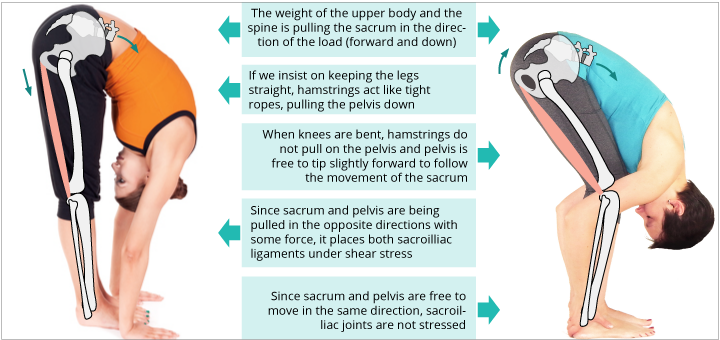Uttanasana (Standing Forward Bend)
Source: "Yoga anatomy" written by Leslie Kaminoff
"Uttanasana reminds me of a waterfall, the legs being the cliffs from which the trunk is flowing down like water – make the legs strong and tall and the trunk soft and flowing!"
from Eyal Shifroni in "Props for yoga - Volume 1: Standing asanas"
This healing, powerful and rejuvenating asana that soothes the mind, work and stretches the hamstrings, gastrocnemius, piriformis muscles, spinal muscles, and so many others muscles and connective tissues.
- Stand in Tadasana (Mountain Pose).
- On inhale circle the arms up in Urdhva Hastasana, extending from the low belly up through the fingertips.
- Maintaining the length, on exhale and hinging from the hips, bend forward in order to have the trunk folding over the legs and resting the palms on the floor by the sides of the feet. If you need to bend the knees, maintaining the contact of the belly with the thighs and stacking the hips over the ankles.
- Extend the trunk down. Relax the abdomen, the head and the neck.
- Keep the legs engaged by pushing the kneecaps up (drawing up the thigh muscles).
- To get out of the pose contract the core and the abdomen muscles pushing the navel toward the spine. Place the hands on the hips and on inhaling rise slowly with the spine straight, ensuring there is an elongation in your back. Slowly stand up.
In this pose as many others in yoga, the gravity should do the work drawing the torso down.
Having this in consideration, if you feel tension, strain or simply have tight hamstrings, in order to prevent you to pull yourself down (due to the hamstrings working in this case as tightropes), which will cause tightness and congestion in the psoas, rectus femoris and placing the sacroiliac ligaments under shear stress, it's better to soften the knees giving breathing space in the pelvis and sacrum and allowing the spine to release.
Only when you feel this release in the spine, is when you should extend the legs, providing you more lengthening in all the back part of the body.
Source: "Yoga anatomy" written by Leslie Kaminoff
from squencewiz.org "To Many Asymmetrical Poses Can Create Sacroiliac Joint Issues"












Comments
Post a Comment